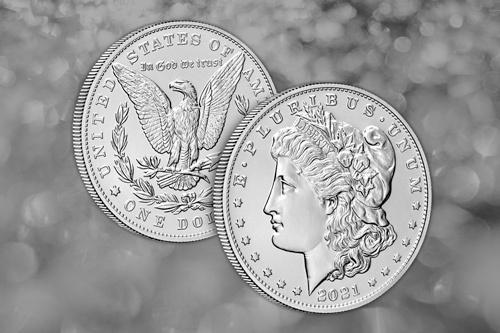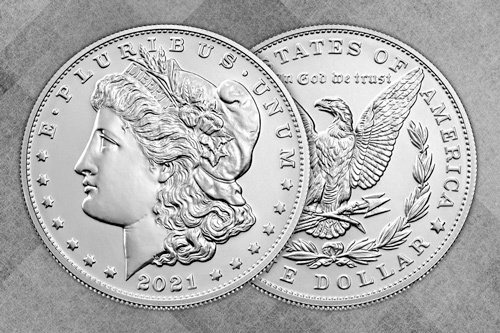
2021 Morgan Silver Dollar U.S. Mint Launch
One hundred years ago, what has become one of the most recognizable coins in United States history – the Morgan Dollar – took its final mintage lap, closing the book on its storied history. Until now.
To commemorate the 100th anniversary of the final 1921 production year of the original Morgan silver dollars, the U.S. Mint has embarked on an ambitious project to bring five separate modern-day Morgan Dollar strikes to the American public in 2021.
Beginning in late May, the U.S. Mint began pre-selling its 2021 Morgan Dollars, which were slated to be launched in two two-coin installments and a final one-coin installment throughout the summer (all coins would start shipping in the fall, according to the Mint). Kicking off the 21st-century Morgan Dollar project were two issues that represent now-shuttered Mint outposts, at which some of the original late-19th and early-20th century Morgan Dollars were struck – the New Orleans and the Carson City, Nevada mints. These two initial offerings each bear a privy mark representing one of the two Mint outposts – one with an “O” privy mark, representing the New Orleans Mint, and the other with a “CC” privy mark, representing the Carson City Mint. Since these two Mint locations are no longer operational, the coins representing them were struck at the Philadelphia Mint and bear privy marks to recognize the two locations instead of mint marks.
While the next two-coin installment of the 2021 Morgan Dollars was initially slated for release shortly after the first-round launches, the Mint pushed the dates of round two and its final round three back in response to controversy and customer complaints surrounding the project’s initial releases. According to an email announcement sent by the Mint in late June, “the Mint experienced an extraordinarily high volume of BOT traffic” during the pre-sale window of its first two 2021 Morgan Dollars and noted that the BOTs were “programmed to conduct technology-driven transactions which caused significant interference with many transactions by Mint customers.” This interference inhibited numerous would-be coin purchasers from having what was perceived to be a fair chance at snagging the high-demand Morgan Dollars.
According to a Coin World report published just a few days after the launch of the "CC" and "O" 2021 Morgan Dollars, first-day sales of the Carson City issue totaled 174,004 coins and 173,607 coins for the New Orleans issue. According to the Mint’s Cumulative Sales Figures report reflecting sales through the week ending August 1, 2021, the “CC” privy mark issue totaled 171,390 coins sold, while the “O” privy mark issue totaled 171,843 coins sold (the figures are different presumably to account for returned orders, canceled orders, and other such anomalies).
The Mint spent much of the ensuing weeks working to revamp its website to thwart such snafus from happening again. Finally, the second two-coin installment of the Morgan Dollar commemorative coin project was launched in early August 2021. Like the first two coins, these second-round issues represent two of the U.S. Mint’s regional outposts – the Denver Mint and the San Francisco Mint. Since both the Denver and San Francisco mints are still operational Mint facilities today, a batch of the 2021 Morgan Dollar was struck at each location (as opposed to at the Philadelphia Mint, as was the case for the first two coins), with pieces from each batch bearing the respective mint mark (versus a privy mark) of its respective strike location. Coins minted in Denver bear a "D" mint mark, and coins minted in San Francisco bear an “S” mint mark.
Starting Tuesday, August 10, 2021, at noon Eastern time, the Mint will open pre-sale orders for its fifth and final 2021 Morgan Dollar issue. This third launch installment will include just a single coin, struck at the Philadelphia Mint, like the first two issues, although this coin will not feature a mint or privy mark.
Per the U.S. Mint's Product Catalog, each issue of the 2021 Morgan Dollar will be subject to a 175,000-coin product limit but no mintage limit. Only the Philadelphia-produced coin with no mint or privy mark set to be released on August 10th appears to be subject to a household order limit, set at three.
Wholesale Coins Direct clients will have the opportunity to add these silver dollar pieces to their asset holdings. 2021 Morgan Dollars purchased from Wholesale Coins Direct will be graded at the highest MS70 level – the top quality score available for “Uncirculated” strike types (more on “Uncirculated” coins and their grades below).


Features and Specifications of the 2021 Morgan Dollar Coins
Outside of their varying privy or mint marks (or lack thereof), the five 2021 Morgan Dollars all boast uniform features and specifications. Each 2021 coin comprises .858 troy ounces of 99.9% fine silver and carries the same $1 face value as the Morgan Dollar did during its original runs in the late 19th and early 20th centuries. However, the original coins contained a metal mix of 90% silver and 10% copper, versus the 99.9% silver contents found in today’s issues.
The 2021 Morgan Dollars are finished in the striking “Uncirculated” fashion. Similar to proof coins, coins issued by the U.S. Mint under what it calls the “Uncirculated” finish are assessed – or graded – according to the Sheldon scale. The Sheldon scale includes numeric grades ranging from 1 on the low end (indicating the most inferior quality) and 70 on the high end (indicating the best quality). “Uncirculated” coins that receive a numeric grade of 60 or higher receive the label “Mint State,” which is abbreviated “MS.” An “Uncirculated” coin receiving the highest quality grade, then, would be labeled “MS70.”
The five 2021 releases all bear the same obverse and reverse designs as the original Morgan Dollar, which began production in 1878. This pair of designs was created by George T. Morgan, a British coin die engraver hired by U.S. Mint Director Henry Linderman in the late 1870s to serve as Assistant Engraver at the Philadelphia Mint under Chief Engraver, William Barber. The obverse shows a side profile portrait of Lady Liberty, for which Morgan used Philadelphia resident Anna Willess Williams as his model. In Morgan’s rendition, Liberty wears what appears to be a Phrygian-like cap that is adorned with various “flora,” as the Mint describes it, and the word "LIBERTY," stitched on its brim. Along the top curve of the obverse design on both the original and the 2021 Morgan Dollar appear the words, "E PLURIBUS UNUM," the motto found on the Seal of the United States and means, “Out of many, one.” Several six-point stars appear on either side of Liberty’s portrait – seven on the left side, six on the right side, for a total of thirteen – along with the coin’s strike date along the bottom edge of the coin.
The reverse of the Morgan Dollar – for both the original and the 2021 issues – shows an American heraldic eagle with outstretched wings clasping an olive branch and a bundle of arrows in its talons. The bird is centered within a half-circle wreath and is surrounded by the words "UNITED STATES OF AMERICA" along the top rim of the coin and the coin’s “ONE DOLLAR” face value along the bottom edge. The two sets of words are separated by a single six-point star on both the left and right sides. The nation’s motto, “In God we trust,” is inscribed just above the bird’s head, in between the tips of its outstretched wings. For the coins that boast a privy or mint mark indicating its production location or location of mention – on both the 2021 and original issues – the insignia appears just above the "D" and "O" in the word "DOLLAR."
While the Mint matched Morgan’s original design for its 2021 issues, it notes in a press release that the team revisited and utilized “historical assets” “such as coins, dies, and high resolution images to capture the artists’ original intent,” but “modernized the new Morgan…Dollar Anniversary Coins to match current commemorative coin specifications.”
Silver Morgan Dollar History
The original Morgan Dollar was authorized by Congress in 1878 via a bill that became known as the Bland-Allison Act.
The Bland-Allison Act was a response to the United States’ fourth Coinage Act, which was passed five years earlier in 1873. In addition to effectively ending the bimetallic standard in the United States, the Coinage Act of 1873 also put an end to the practice of “free silver,” a process that allowed people to take silver bullion to one of the U.S. Mint locations scattered across the country to be turned into legal tender coins for a small charge. Bullion producers would capitalize on this process and turn their bullion supplies into legal tender coins when the value of silver dipped below the dollar face value of the coins they were having struck, allowing the producers to profit when silver prices were down. The Coinage Act of 1873 also ended production of the country’s standard silver dollar, which, at the time, took the form of the Seated Liberty Dollar, paving the way for mintage of a silver trade dollar instead. The same "free silver" process leveraged previously by bullion producers soon retook shape under this new trade dollar provision, only to be restricted yet again in 1876.
In response to the recurring restrictions on “free silver” that continued cropping up in the wake of the 1873 Coinage Act, several bills were introduced in the U.S. House of Representatives in support of resuming the practice. A bill introduced by Representative Richard Bland of Missouri was passed in the House in the fall of 1876 and sent to the Senate for final congressional approval. However, during the amendment process in the upper chamber, which William Allison of Iowa spearheaded, the “free silver” provision was struck from the bill. Allison’s amendments also allowed for silver certificates to be issued for the first time in U.S. history. After the amended bill received Congressional approval, President Rutherford B. Hayes vetoed it. The veto was, in turn, overridden by Congress, and the bill was allowed to pass into law in February of 1878, as what would become known as the Bland-Allison Act.
In addition to nixing the practice of free silver and introducing silver certificates, the newly authorized Bland-Allison Act required the U.S. Treasury to purchase monthly quantities of domestically mined silver that were to be worth between two and four million dollars. The monthly silver supplies were, in turn, to be coined into silver dollars. These silver dollars would come to be known as the Morgan Dollars.
Mintage of the newly authorized Morgan Dollars began at the Philadelphia Mint just over a week after the Bland-Allison Act was passed. The Mint was on the hook to produce a monthly quota of the new silver dollars, which resulted in pressure so great at the Philadelphia Mint that all other coin production there was halted, and overtime operations were adopted in order to meet the steep requirements. In light of the intense situation on the East Coast, the Mint’s Director, Henry Linderman, set out to involve the western mints located in San Francisco and Carson City to alleviate some of the pressure. Since George Morgan’s dies were prepared only at the Philadelphia Mint, however, the commissioning of the San Francisco and Carson City mints was delayed, and production would not begin at those locations until mid-April 1878 – slightly more than a month after mintage began in Philadelphia. Morgan Dollars were produced at the New Orleans Mint starting in 1879.
Morgan Dollar production continued relatively steadily until the passage of the Sherman Silver Purchase Act in 1890, which, because of the Act’s mandate for the Treasury to increase its monthly silver purchase to 4.5 million troy ounces, would first lead to a significant surge in silver dollar production, followed by sharp drops beginning in 1892. The Panic of 1893 followed, which saw numerous runs on banks and bank failures in light of several industrial firms going bankrupt. This financial turmoil spurred then-President Grover Cleveland to call a special session of Congress to repeal the Sherman Silver Purchase Act, a piece of legislation he viewed as having inflicted the current economic pain on the country thanks to the inflation triggered by the law. Congress repealed the Sherman Act on November 1, 1893, and four and a half years later, in June of 1898, ordered all remaining bullion supplies purchased under the Sherman Act to be coined into silver dollars. The bullion supply was depleted in 1904, and, as a result, production of Morgan Dollars ceased that year.
Fourteen years later, in 1918, what became known as the Pittman Act was passed in response to German propaganda efforts during World War I to discredit British currency in India, which was under British rule at the time. The propaganda worked and led to a run on the United Kingdom’s silver supply, inflating silver prices and threatening financial turmoil for the empire, a situation that would be hugely consequential for Western powers during wartime. The Pittman Act, which U.S. Senator Key Pittman of Nevada introduced as a way to offer financial relief to the British – an ally of the U.S. – authorized the melting down of up to 350 million U.S. silver dollars and the selling of that silver to the U.K. (or any “foreign governments at war with the enemies of the United States,” for that matter) to bolster the country’s silver supply and monetary system at large. Additionally, the Pittman Act authorized a replacement coin to be minted for every silver dollar melted, which led to the production of the Morgan Dollar resuming in 1921, the only year the Morgan Dollar was struck at the Mint outpost in Denver.
The Morgan Dollar remains a significant and integral part of the United States’ financial history. With the release of its 2021 Morgan Dollars, the U.S. Mint aims to commemorate and reinvigorate the exciting legacy of this silver coin, an important new chapter in the coin’s already storied tenure.











